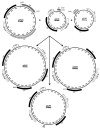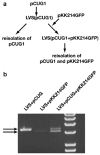Development of novel plasmid vectors and a promoter trap system in Francisella tularensis compatible with the pFLN10 based plasmids
- PMID: 17459476
- PMCID: PMC2013926
- DOI: 10.1016/j.plasmid.2007.03.002
Development of novel plasmid vectors and a promoter trap system in Francisella tularensis compatible with the pFLN10 based plasmids
Abstract
Francisella tularensis is a category A bioterror pathogen which in some cases can cause a severe and fatal human infection. Very few virulence factors are known in this species due to the difficulty in working with it as well as the lack of tools for genetic manipulation. This work describes the construction of a shuttle vector that can replicate in Escherichia coli and F. tularensis as well as two distinct promoter trap constructs based on the shuttle vector backbone. Replication in F. tularensis is based on the promiscuous origin of replication from the Staphylococcus aureus plasmid pC194. We demonstrate the novel plasmids can coexist with established F. tularensis vectors based on the pFNL10 plasmid, the current workhorse of F. tularensis genetics. Our promoter trap can identify promoters that are activated during intracellular growth and survival. These new vectors provide additional tools for the genetic manipulation of F. tularensis.
Figures





References
-
- Bina XWR, et al. The Bla2 beta-lactamase from the livevaccine strain of Francisella tularensis encodes a functional protein that is only active against penicillin-class beta-lactam antibiotics. Arch Microbiol. 2006;186:219–228. - PubMed
-
- Dennis DT, et al. Tularemia as a biological weapon: medical and publichealth management. JAMA. 2001;285:2763–2773. - PubMed
Publication types
MeSH terms
Substances
Grants and funding
LinkOut - more resources
Full Text Sources

